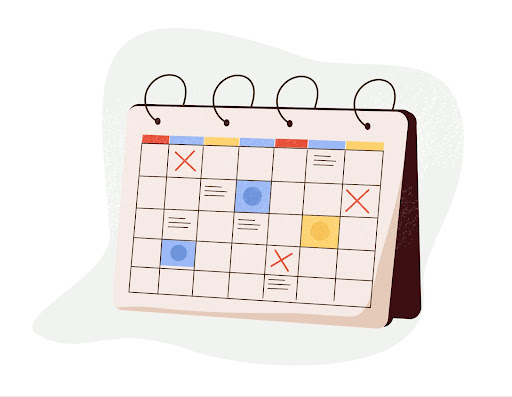In today’s fast-paced digital landscape, content is king, but organization is the queen that rules the kingdom. And she is a benevolent ruler when you have a solid content calendar. While most businesses understand the power of content marketing, many need help executing it consistently and effectively.
That’s where a content calendar comes into play. This indispensable tool serves as the backbone of your content strategy — helping you plan, coordinate, and track all your content activities.
In this comprehensive guide, we’ll delve into five compelling reasons why having a content calendar is a must for your content marketing, and we’ll even walk you through creating one step-by-step so you’ll know exactly what to do.
Read on to discover how a well-structured content calendar can elevate your marketing game, align your team, and drive tangible results for your business.
5 Reasons Why You Need a Content Calendar
There are five reasons why you’ll want a content calendar for your content marketing and your business overall: consistency, collaboration, quality, strategy, and efficiency. Let’s dive in!
- Consistency is key. Consistency builds trust and credibility, enhances SEO, engages your audience, strengthens your brand identity, and drives traffic and conversions.
- Builds trust and credibility: Consistency in posting helps build trust with your audience. When you post regularly, your audience knows what to expect and when to expect it, thereby establishing your brand as a reliable source of information.
- Enhances SEO: Search engines favor websites that regularly update their content. Consistent posting improves your website’s SEO, making it easier for people to find you online.
- Engages your audience: Consistency keeps your audience engaged. A regular posting schedule means your audience has something to look forward to, which can increase user engagement and interaction rates.
- Strengthens brand identity: Consistent posting helps reinforce your brand’s message and identity. It allows you to create a cohesive narrative over time, which is crucial for brand recognition.
- Drives traffic and conversions: Regularly updated content will drive more traffic to your website. More traffic often leads to higher conversion rates, as you have more opportunities to turn visitors into customers.
So, how does a content calendar help you maintain consistency?
- Scheduled posts: A content calendar lets you plan and schedule your posts in advance, ensuring you never miss a publishing date.
- Content diversity: With a content calendar, you can plan a diverse range of topics and formats, ensuring you’re not repetitive and keeping your audience engaged.
- Time management: Knowing what to post and when allows you to manage your time more efficiently, giving you extra time to focus on creating high-quality content.

- Your team’s collaboration will improve. Working with a team has its challenges. You might deal with communication issues, overlapping resources, inconsistent messaging, missing deadlines, and struggling with quality control. Well, a content calendar will help with that.
- Lack of communication: Poor communication is one of the biggest challenges in team collaboration. Team members may have differing views about deadlines, responsibilities, or even the overall content strategy.
- Resource overlap: Without a centralized system, multiple team members might end up working on similar tasks, leading to redundancy and wasted resources.
- Inconsistent messaging: When multiple people contribute to content without a unified strategy, the brand message can become inconsistent, confusing the audience.
- Missed deadlines: Without clear planning and coordination, deadlines are easily missed, affecting the overall content schedule and, consequently, the marketing strategy.
- Quality control: In a team setting, maintaining a consistent level of quality across all pieces of content is challenging, especially when different team members have varying levels of expertise and writing styles.
So, how does a content calendar facilitate better communication and teamwork?
- Centralized planning: A content calendar serves as a centralized platform where all tasks, deadlines, and responsibilities are clearly outlined. This ensures everyone knows what they are supposed to do and when.
- Transparency: With a content calendar, team members can easily see who is responsible for what, reducing overlap and redundancy.
- Scheduled check-ins: Regularly scheduled meetings set around the content calendar’s deadlines will facilitate better communication and timely updates.
- Content review and approval: A content calendar can include stages for content review and approval, ensuring quality is maintained across all content pieces.
- Real-time updates: Modern content calendar tools allow for real-time updates, so everyone is immediately informed if there’s a change in strategy or a shift in responsibilities.
Tools for Content Calendars to Improve Collaboration
- Trello: Trello’s card-based system is excellent for organizing content ideas and tracking their progress. Team members can comment, attach files, and even integrate third-party apps.
- Asana: Asana offers detailed project timelines and task assignments, making managing complex content strategies with multiple team members easier.
- Google Calendar: For smaller teams or simpler projects, Google Calendar can serve as a basic but effective content calendar. You can set reminders, share the calendar, and even attach documents to specific dates.
- CoSchedule: Specifically designed for content marketing, CoSchedule offers a range of features like content/social media scheduling, task assignments, and analytics.
- Monday.com: This tool offers customizable workflows that adapt to your specific content creation process, making it easier for team members to collaborate.
A content calendar significantly improves communication and teamwork by addressing team collaboration challenges and utilizing the right tools, making your content marketing efforts more effective and streamlined.
- It helps with quality over quantity. Quality content builds trust and authority, enhances the user experience, boosts SEO rankings, drives engagement and shares, and converts visitors into customers.
- Builds trust and authority: High-quality content establishes your brand as an authority in your field. When you provide valuable, well-researched information, your audience is more likely to trust you and consider you a go-to source.
- Enhances user experience: Quality content is informative, engaging, and easy to read. This improves the user experience, encouraging visitors to spend more time on your site and interact with your content.
- Boosts SEO rankings: Search engines prioritize high-quality, relevant content. Well-crafted articles that answer user queries are more likely to rank higher in search results.
- Drives engagement and shares: Quality content is more likely to be shared on social media, extending your reach and attracting a broader audience.
- Converts visitors into customers: High-quality content can be a powerful tool for conversion. By providing value, you build a relationship with your audience, making them more likely to become paying customers.
So, how does a content calendar help in creating high-quality content?
- Time management: Planning your content in advance gives you ample time to research, write, edit, and revise, ensuring the final output is high quality.
- Resource allocation: Knowing what content needs to be created allows you to allocate the right resources, whether hiring a subject matter expert for a technical article or allocating more time for an in-depth piece.
- Content review: A content calendar can include time for multiple rounds of reviews and revisions, ensuring that the content meets quality standards before it’s published.
- Strategic focus: With a content calendar, you can align your content with key business objectives, ensuring that each piece serves a specific purpose and is of high quality.
- Avoids last-minute rush: Planning ahead eliminates the need for last-minute content creation, often compromising quality.

Tips for Balancing Quality With Quantity
- Prioritize core content: Focus on creating high-quality core content that serves your primary business objectives. Supplement this with shorter, easier-to-produce pieces.
- Repurpose content: One high-quality piece can be repurposed into various formats like blog posts, videos, podcasts, and social media snippets, maximizing output without sacrificing quality.
- Set realistic goals: Don’t overcommit. It’s better to produce fewer high-quality pieces than to churn out a lot of low-quality content.
- Quality metrics: Use metrics like engagement rates, time spent on the page, and conversion rates to measure the quality of your content, rather than simply looking at the number of pieces produced.
- Scheduled reviews: Review your content calendar periodically to ensure you balance quality and quantity.
- Your content strategy will be better. Who’s game for a better content strategy? We are! A better content strategy provides a holistic view and enables thematic planning, resource allocation, performance tracking, and flexibility.
- Holistic view: A content calendar provides a bird’s-eye view of your entire content strategy, making it easier to identify gaps, overlaps, and opportunities for synergy between different pieces of content.
- Thematic planning: With a content calendar, you can plan around themes or campaigns, ensuring that each piece of content contributes to a larger narrative or goal.
- Resource allocation: Knowing what content will be produced and when it will be produced allows you to allocate resources more efficiently, whether it’s a budget for paid promotion or time for content creation and review.
- Performance tracking: A content calendar serves as a tracking tool, helping you understand what’s working and what’s not. This enables you to make data-driven decisions and refine your strategy over time.
- Flexibility: While a content calendar provides structure, it also offers the flexibility to make adjustments as needed, whether in response to current events, changes in business strategy, or performance metrics.
So, why is aligning your content with your business goals and objectives important?
- Targeted messaging: Aligning content with business goals ensures your messaging is targeted and relevant, increasing the likelihood of achieving desired outcomes like lead generation or brand awareness.
- ROI measurement: When content is aligned with specific business objectives, it becomes easier to measure ROI. You can directly correlate the success of your content marketing efforts with business metrics.
- Resource optimization: Knowing your business goals helps you allocate resources more effectively, focusing on high-impact activities that drive business growth.
Examples of How a Content Calendar Can Help in Achieving Business Goals
- Lead generation: If one of your business goals is to generate leads, your content calendar can include a series of educational webinars, how-to guides, and case studies designed to capture email addresses.
- Brand awareness: For increasing brand awareness, your content calendar could include a mix of blog posts, social media updates, and PR activities that highlight your brand’s unique value proposition and reach a broader audience.
- Customer retention: If customer retention is a key objective, your content calendar might feature a series of post-purchase guides, customer testimonials, and loyalty program promotions to keep existing customers engaged.
- Product launch: For a product launch, your content calendar could outline a multi-channel campaign that includes teaser videos, launch-day webinars, and follow-up content that addresses common questions and showcases the product’s features.
- Seasonal campaigns: If your business has seasonal peaks, a content calendar will help you prepare well in advance, ensuring that you capitalize on these crucial periods with targeted content.
You can create a more focused, effective, and measurable strategy using a content calendar to align your content marketing activities with your business goals.

- It will help you efficiently allocate resources. A content calendar clearly shows who is responsible for each task, avoids overlapping, and helps with time management, budgeting planning, and skill matching.
- Clear task assignment: A content calendar clearly outlines who is responsible for each task, eliminating confusion and ensuring everyone knows their role.
- Time management: With a content calendar, you can allocate specific time slots for each task, helping team members manage their time more efficiently.
- Budget planning: Knowing what content needs to be produced allows you to allocate a budget for things like freelance writers, graphic designers, or paid promotions.
- Skill matching: A content calendar helps you match the right people with the right tasks, ensuring that someone with the appropriate skills and expertise creates each piece of content.
- Avoids overlapping: A centralized system avoids resource overlap and redundancy, ensuring that each team member is fully utilized but not overworked.
Benefits of Knowing Who Is Doing What and When
- Accountability: When tasks and deadlines are clearly defined, team members are more accountable for their work, leading to better outcomes.
- Collaboration: Knowing who is responsible for what makes collaborating easier, as team members can easily identify whom to consult for specific tasks or projects.
- Efficiency: A clear understanding of roles and timelines reduces the time spent on coordination, allowing more time for actual content creation.
- Quality control: Maintaining consistent quality across all content is easier when everyone knows their responsibilities and deadlines.
- Strategic alignment: Knowing who is doing what and when ensures that all activities are aligned with the overall content strategy and business objectives.
Tips for Effective Resource Allocation Using a Content Calendar
- Prioritize tasks: Use the content calendar to prioritize tasks based on their impact and urgency, ensuring that essential activities are addressed.
- Resource buffer: Always allocate some buffer resources for unexpected tasks or revisions so you don’t end up overloading your team.
- Regular updates: Keep the content calendar updated in real time to reflect any changes in tasks, deadlines, or resource allocation.
- Skills inventory: Maintain an inventory of team members’ skills and expertise so you can quickly allocate resources for new tasks that come up.
- Review and adjust: Periodically review the content calendar to see if resources are being utilized effectively and make adjustments as needed.
- Use technology: Utilize content calendar tools that allow you to track resource allocation, time spent, and task status, providing valuable data for future planning.
Now that we’ve looked at the five reasons why you need a content calendar, let’s look at how to create one for your content marketing.

How to Create a Content Calendar: A Step-by-Step Guide
Creating a content calendar will streamline your content marketing efforts, ensuring you’re organized, consistent, and aligned with your business goals. Here’s a step-by-step guide to help you create an effective content calendar.
Step 1: Define Your Goals and Objectives
- Identify business goals: Understand what you aim to achieve with your content marketing — be it brand awareness, lead generation, customer retention, etc.
- Set key performance indicators: Define KPIs to measure the success of your content marketing efforts.
Step 2: Know Your Audience
- Create buyer personas: Identify your target audience’s characteristics, needs, and preferences.
- Conduct surveys: Use surveys or social media polls to understand what kind of content your audience prefers.
Step 3: Conduct a Content Audit
- Inventory existing content: List all your existing content and categorize it.
- Identify gaps: Look for topics or formats you haven’t covered but should.
Step 4: Decide on Content Types and Channels
- Choose content types: Decide what types of content you’ll produce — blogs, videos, podcasts, etc.
- Select channels: Identify where you’ll publish this content — your website, social media platforms, email newsletters, etc.
Step 5: Create a Content Repository
- Brainstorm ideas: Gather your team and brainstorm content ideas.
- Categorize ideas: Sort these ideas based on themes, urgency, or other criteria relevant to your business.
Step 6: Allocate Resources
- Assign tasks: Decide who will be responsible for each piece of content.
- Set deadlines: Establish a timeline for each task, from research and creation to editing and publishing.
Step 7: Choose a Content Calendar Tool
- Evaluate options: Look at different tools like Google Calendar, Trello, Asana, or specialized content calendar software.
- Select a tool: Choose one that fits your team’s needs and budget.
Step 8: Populate Your Content Calendar
- Add tasks: Input all the tasks, deadlines, and responsible team members into the content calendar tool.
- Include details: Add any relevant details like the content format, target keywords, and publishing channels.
Step 9: Implement and Execute
- Start creating: Begin the content creation process based on the calendar.
- Monitor progress: Regularly check the content calendar to track progress and make any necessary adjustments.
Step 10: Review and Revise
- Analyze performance: After a set period, review the KPIs to measure the success of your content.
- Make adjustments: Based on the analysis, make any necessary changes to your content strategy or calendar.
Bonus Tips
- Be flexible: Always be prepared to make adjustments for unexpected opportunities or challenges.
- Regular updates: Keep your content calendar updated in real time to reflect any changes in tasks or strategy.
- Team meetings: Hold regular meetings to discuss the content calendar, upcoming tasks, and any challenges.
So, there you have it!
Those are the five reasons why you need a content calendar for your content marketing strategy and your step-by-step guide to creating that calendar.
Create Your Content Calendars With Revity Marketing
Ready to take your content marketing to the next level? Don’t navigate the complex world of digital marketing alone. Reach out to the experts at Revity Marketing today!
We specialize in crafting tailored marketing strategies that drive results, and we can help you create and manage an effective content calendar that aligns with your business goals. That’s not to mention all the other services we offer that might be a perfect fit for your business’s digital marketing needs!
Don’t leave your success to chance; let us help you achieve the measurable results you desire. Contact Revity Marketing now for all your marketing needs. Call us at 801.877.3362, or schedule an appointment through our website. Let’s embark on this digital marketing journey together!







